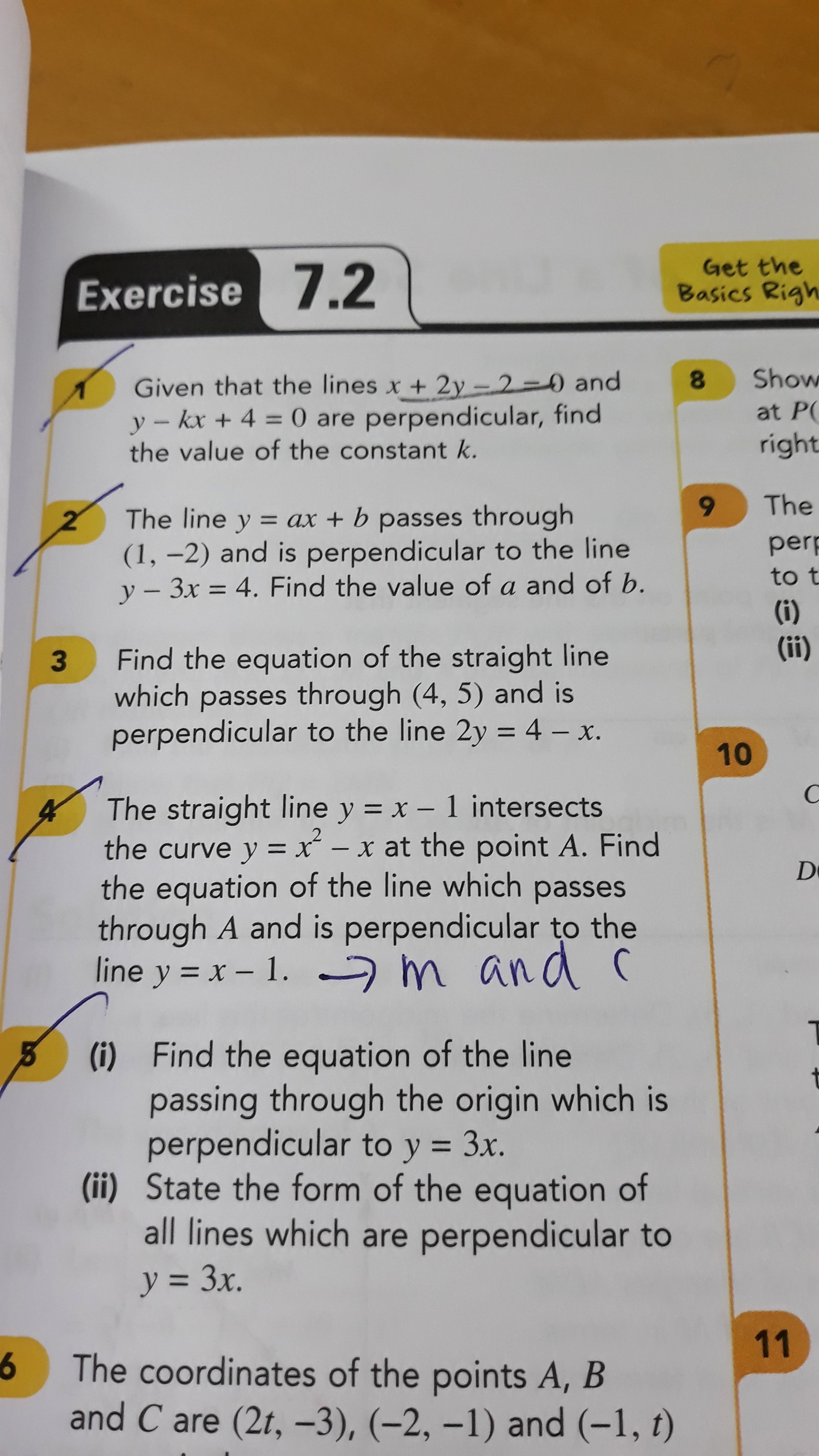Ask Singapore Homework?
Upload a photo of a Singapore homework and someone will email you the solution for free.

Question
secondary 3 | A Maths
No Answers Yet
Help May! Anyone can contribute an answer, even non-tutors.

I dont understand the questions.
I want the full solutions for question 2,4 and 5
To form the equation of a straight line, we need these two things. The gradient of the line (the "m") and a point on the line (to obtain our value of "c").
Do we have the gradient here? No...
But instead, they mentioned something about "is perpendicular to the line y - 3x = 4".
Do we have the point on the line here? Yes, the line passes through (1, -2).
Ok, so the issue here is that we do not have the gradient of our wanted line. But what does "is perpendicular to the line y - 3x = 4" mean?
Since we need to obtain the gradient of our wanted line and we are given information about y - 3x = 4, it means that this information must have something to do with our wanted gradient. But what is it exactly?
If you rearrange the equation y - 3x = 4 into the form y = 3x + 4, you can identify this line as having a gradient of 3 (the y-intercept here is actually redundant).
Now, this line with a gradient of 3 is perpendicular to our wanted line. But what does this exactly mean?
Well, for any two perpendicular lines, the product of their gradients must equal to -1 (note that this is a property which cannot be proven at the Secondary level, so we'll accept this to be a fact at the Secondary level).
In other words, we need to find a number such that its product with 3 gives us -1.
This number is -1/3, so the gradient of our wanted line is -1/3. Now, we are ready to form our equation.
y = ax + b
y = -1/3 x + b
So, a = -1/3.
Since (1, -2) is on the line, we can substitute x = 1 and y = -2 into our equation to obtain the y-intercept b.
-2 = -1/3 (1) + b
-2 = -1/3 + b
-6/3 = -1/3 + b
-5/3 = b
And therefore, a = -1/3 and b = -5/3.
To form the equation of a straight line, we need these two things. The gradient of the line (the "m") and a point on the line (to obtain our value of "c").
Do we have the gradient here? No...
But instead, they mentioned something about "is perpendicular to the line y = x - 1". Does this ring a bell to you?
Do we have the point on the line here? No...
But instead, they gave something about point of intersection between a line and a curve at a point A.
We need to work on these two pieces of information separately, one for the gradient and one for the point.
We can identify y = x - 1 as a line with a gradient of 1 (again, the y-intercept is not required for this question). Since this line is perpendicular to our wanted line, the product of their gradients must equal to -1.
In other words, we need to find a number which is multiplied to 1 to get -1.
And this number must be -1, so the gradient of our wanted line is -1.
Gradient solved. Now how about the point?
The point which we need to find is the intersection of a straight line and a curve. We equate the two given equations simultaneously to obtain the values of x and y, both of which will form the coordinates of point A.
y = x - 1
y = x² - x
At the point of intersection,
x² - x = x - 1
x² - 2x + 1 = 0
(x - 1) (x - 1) = 0
x - 1 = 0 or x - 1 = 0 (identical)
x = 1
y = x - 1
y = 1 - 1
y = 0
So, the coordinates of A are (1, 0).
Point solved.
Now, we are ready to form our equation, which has a gradient of -1 passes through A (1, 0).
y = mx +c
y = -1x + c
y = -x + c
Substituting x = 1 and y = 0 to obtain c,
0 = - (1) + c
0 = -1 + c
1 = c
So, the equation of our wanted line is y = -x + 1.
To form the equation of a straight line, we need these two things. The gradient of the line (the "m") and a point on the line (to obtain our value of "c").
Do we have the gradient here? No...
But instead, they mentioned something about "is perpendicular to y = 3x".
Do we have the point on the line here? Yes; this is hidden as the origin (0, 0).
We can identify y = 3x as a line with a gradient of 3 (again, the y-intercept is not required for this question). Since this line is perpendicular to our wanted line, the product of their gradients must equal to -1.
In other words, we need to find a number which is multiplied to 3 to get -1.
And this number must be -1/3, so the gradient of our wanted line is -1/3.
Now we have the gradient ready, and we can form the equation of our line.
y = mx + c
y = -1/3 x + c
Substituting x = 0 and y = 0 to obtain c,
0 = -1/3 (0) + c
0 = 0 + c
0 = c
So, the equation of our wanted line is y = -1/3 x.
For all other lines which are perpendicular to y = 3x, we just need the gradient of our wanted line to be -1/3. The y-intercept does not matter since all lines of gradient -1/3 are perpendicular to all lines of gradient 3.
So, the general form for the equation of our wanted lines is y = -1/3 x + c, where c is an arbitrary constant.


